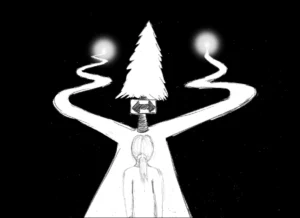 Most of us spend the majority of our time in an emotional state of mind that my teacher, Gary Sherman, calls our “baseline state.” Usually, this habitual way of being is established in childhood, often as a reaction to the underlying tone of our family home or, perhaps, various childhood traumas.
Most of us spend the majority of our time in an emotional state of mind that my teacher, Gary Sherman, calls our “baseline state.” Usually, this habitual way of being is established in childhood, often as a reaction to the underlying tone of our family home or, perhaps, various childhood traumas.
The trouble is, our baseline state is so habitual, so “normal” for us, that we don’t even realize or feel what it is. But you might be able to identify it by getting quiet and tuning in — perhaps to physical tensions in your body. Your baseline state may also reveal itself in habitual thought patterns. Another way to discover your baseline state is to first tune in and then draw a little face caricature of your emotions. Or, imagine that you’re looking into the window of your childhood home and see yourself — what was your state?
For me, I tend to be in a constant, subtle state of free-floating anxiety. There is always a sense that I have to be on alert in case something bad happens suddenly. I believe this state arose from my father’s tendency to have quick and unpredictable bursts of anger, as well as several sudden deaths in my extended family that occurred during my childhood.
Certainly, recognizing one’s baseline state can be eye-opening in and of itself. But what I’d like to talk about today is our innate ability to establish new emotional habits. Lately, I’ve been reading a book called Life On Earth. The author, Mike Dooley, asserts that the underlying goal of our life here on Earth is to be happy. Yes, we might want wealth, love, or success — but it’s because we believe that these things will make us happy.
The truth is, however, that you can be happy at any moment, no matter what is happening. We all have the innate ability to shift our emotional state intentionally, if only for a few seconds. So why not try to create a new habit of shifting your state into happiness, at least for a few brief moments? It’s easier than you think.
How to establish a new habit? One way I’ve discovered is to link the desired habit to an existing routine. For example, over the course of each day, I have to do a series of six exercises for my weak ankle, each taking from 1-4 minutes to perform. I remember to do them by linking each exercise to one of my daily routines — making my hot cereal in the morning, boiling water for coffee, etc. I’ve done this for over a year now, and now whenever I boil the water for my coffee, I automatically do the associated exercise. It’s a habit.
Last week, while meditating, I received an inspiration to try and make happiness a habit. I then engaged in a happiness experiment. I decided to link “happiness” to a routine I do every 2-4 hours — going to the toilet. Each time I do so, I now take approximately 30 seconds to be happy. First I settle using the technique described in Active Consciousness — “Feet. Seat. Back.” That is, I get into the Now by sensing my feet, seat, and back. When I feel settled, I close my eyes and put a smile on my face. Almost immediately I feel a sense of peace and joy within me — indeed, a connection to my inner self. Another thing that can help is imagining something that brings joy — for example, a child or pet. Gratitude also can appear. That’s it!
I’m happy to report that my experiment was a success. I noticed that after “forcing” myself to do this for two or three days, my little happiness shift had become a habit. Now, every time I sit on the toilet, I sense that it’s time to get happy. I don’t need to remind myself. I haven’t yet determined what the net effect will be on my life, but it certainly can’t hurt to be happy for a few moments several times a day!
Do you think you could devote 30 seconds a few times a day to happiness? Try it out. It will only take a total of less than five minutes out of your busy day. Make happiness a habit!




Hi Amy,
I came upon you through searching for Thomas Jacobson because years ago he channeled Dr. Peeples for me for a few years.
I love your happiness habit! I do something like this too, but now will add doing it when I go to the toilet. Perfect!